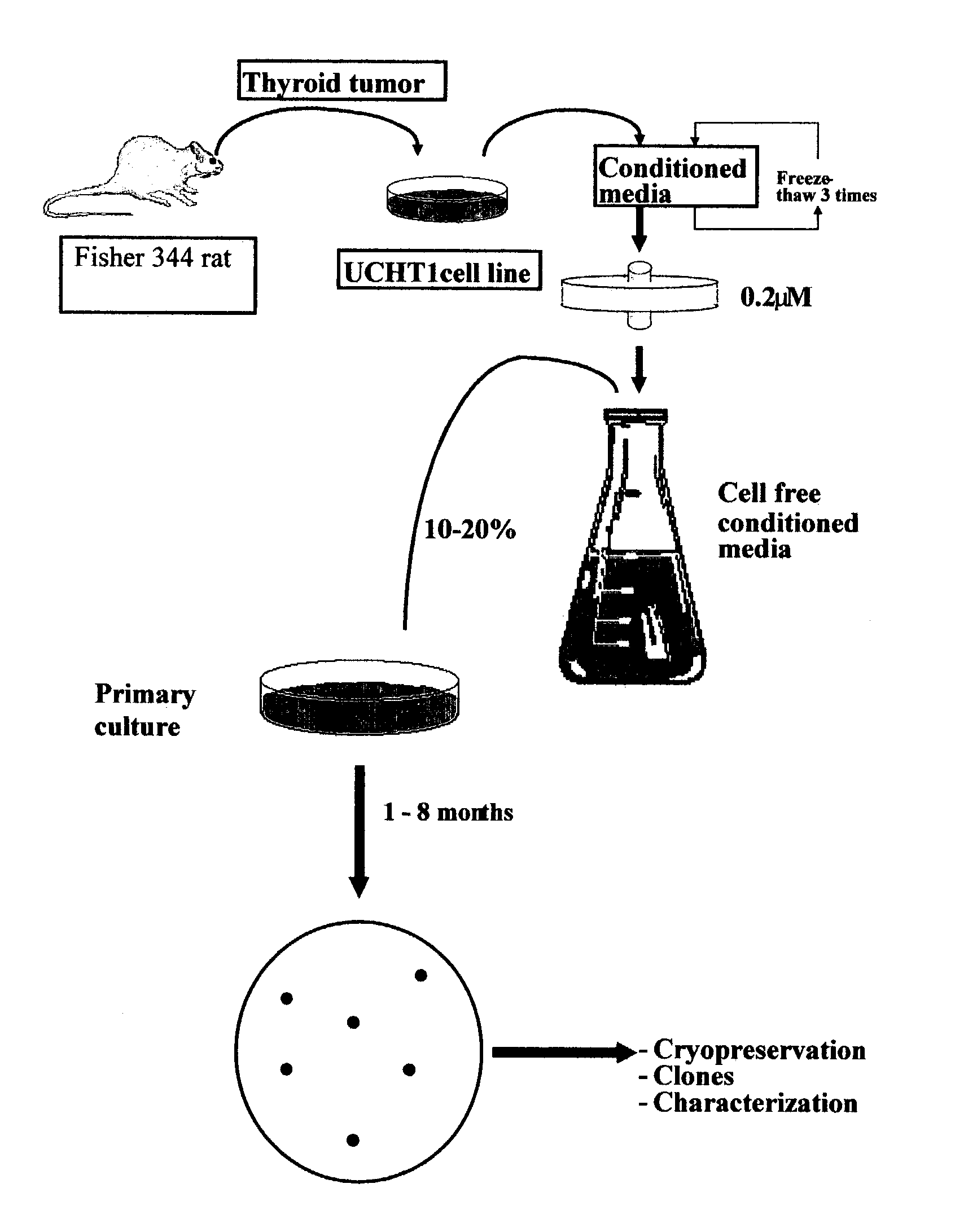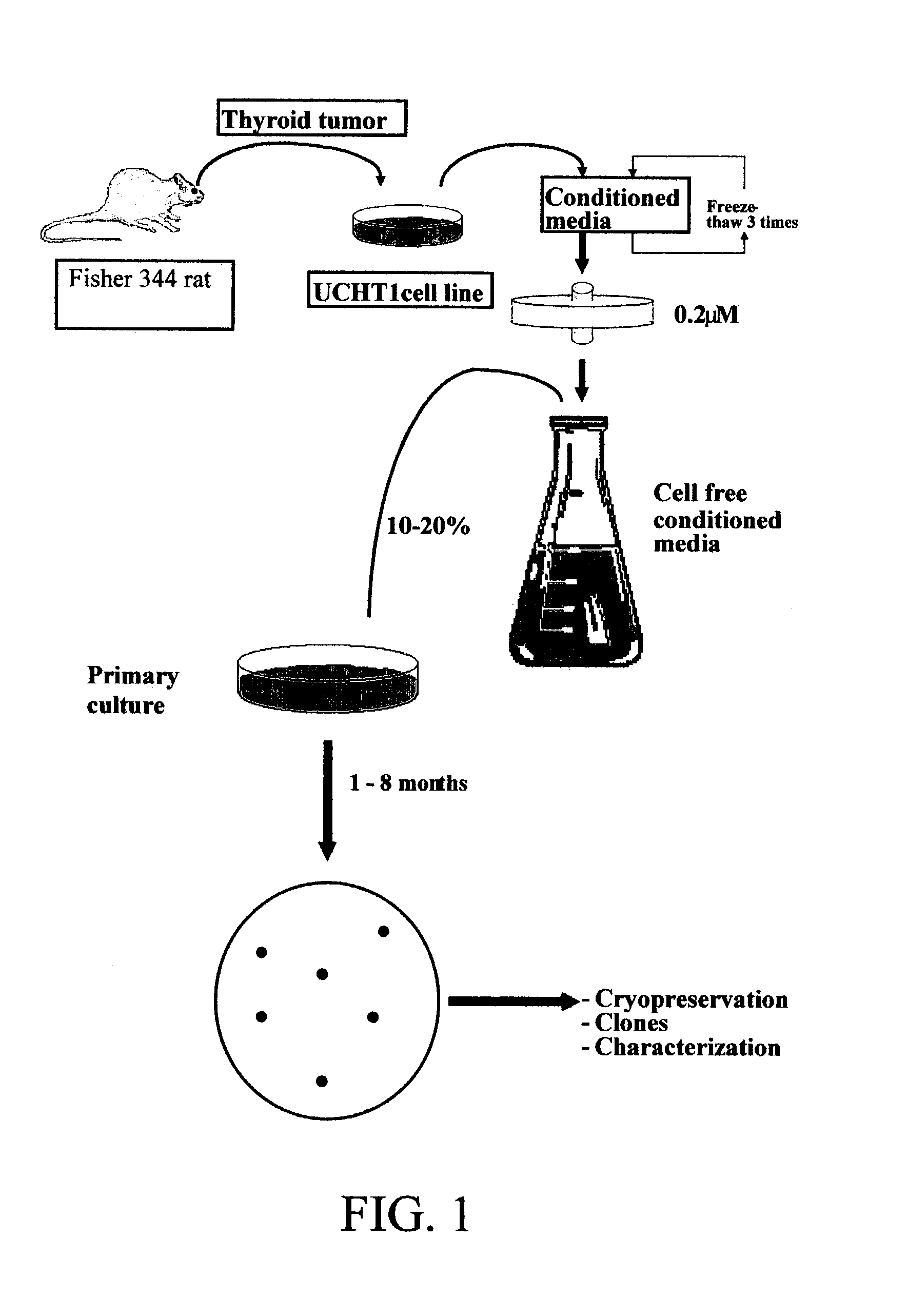Proliferated cell lines and uses thereof
a cell line and cell technology, applied in the field of proliferation cell lines, can solve the problems of limited growth potential of most normal cells in culture, standard culture conditions that do not promote the long-term survival or proliferation of most cells, and immortal cell lines very rarely emerge spontaneously under usual culture conditions, etc., to enhance proliferation duration and/or proliferation rate, and the effect of increasing the proliferation potential of cells
- Summary
- Abstract
- Description
- Claims
- Application Information
AI Technical Summary
Benefits of technology
Problems solved by technology
Method used
Image
Examples
example 1
[0191]A clonal cell line derived from a functional and transplantable rat thyroid tumor was established in continuous monolayer culture by the use of enzymatic dissociation followed by an alternate culture-animal passage procedure (Caviedes, R. and Stanbury J. B., Endocrinology, 1976, 99:549–554). Autonomous and transplantable tumors were used as a cell source for cultures (Matovinovic, J. et al., Cancer Res., 1970, 30:540; Matovinovic, J. et al., Cancer Res., 1971, 31:288). Tumors were developed by implanting thyroid tissue from rats that had been fed on an iodine-deficient diet for 14–18 months into 131I-thyroidectomized animals on a similar diet. After approximately 9 months, the tumors were transplanted to animals on a regular diet. Well-differentiated follicular and function tumors, which arose 6 months later (second generation), were selected to establish serial cultures.
[0192]Cells from several tumors were introduced into monolayer culture through...
example 2
Preparation of UCHT1 Conditioned Medium (UCHT1-CM)
[0194]Glass Petri dishes (15 cm diameter) were inoculated with approximately 5×105 mycoplasma free UCHT1 cells (as described in Example 1) in a mixed solution consisting of equal volumes of Ham F12 and Dulbecco's modified Eagle's medium (F12 / D) supplemented with 10% bovine serum, 2.5% fetal bovine serum, 0.015M HEPES (n-2-hydroxyethylpiperazine-N′-2 ethane sulfonic acid) buffer pH 7.2, 50 mg / i streptomycin sulphate and 100 mg / l sodium-penicillin-G, which was used as the basal growing medium (BGM). Cultures were incubated at 36° C., 100% humidity in an incubator with controlled 10% CO2, 90% air atmosphere and total media changes every three days. UCHT1-CM was collected from exponentially growing cultures and harvested from four subsequent culture periods of 24 hours, obtaining a total amount of 80 mL per dish at the end of the four days; the extensive cell detachment after confluence prevents further UCHT1-CM collection. Finally, UCHT...
example 3
Immortalized Skeletal Muscle Cell Line
[0195]A cell line (RCMH) in permanent culture was established from surgically removed adult normal human skeletal muscle by exposure to conditioned media obtained from thyroid cells. Cells proliferated indefinitely but displayed density inhibition of growth while maintaining some differentiated markers. Under certain incubation conditions, cells fused into myotube-like structures, with a concomitant increase in muscle specific proteins, such as human myoglobin, skeletal muscle myosin, desmin and dystrophin, as identified using immunocytochemical procedures. In addition, RCMH cells displayed high affinity receptors for α-bungarotoxin (Bmax=0.7 pmol / mg protein, Kd=1.5 nM) and dihydropyridines (Bmax=0.3 pmol / mg protein, Kd=0.5 nM for [3H]PN200-110). These values are comparable to those reported for normal muscle cells in primary culture. Patch-clamp studies showed the presence of 42 pS carbachol gated channels and of 5 pS calcium channels (current ...
PUM
| Property | Measurement | Unit |
|---|---|---|
| time | aaaaa | aaaaa |
| melting temperature | aaaaa | aaaaa |
| Tm | aaaaa | aaaaa |
Abstract
Description
Claims
Application Information
 Login to View More
Login to View More - R&D
- Intellectual Property
- Life Sciences
- Materials
- Tech Scout
- Unparalleled Data Quality
- Higher Quality Content
- 60% Fewer Hallucinations
Browse by: Latest US Patents, China's latest patents, Technical Efficacy Thesaurus, Application Domain, Technology Topic, Popular Technical Reports.
© 2025 PatSnap. All rights reserved.Legal|Privacy policy|Modern Slavery Act Transparency Statement|Sitemap|About US| Contact US: help@patsnap.com



